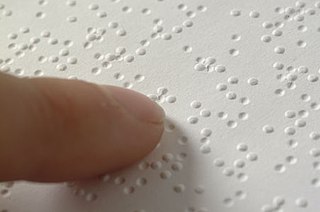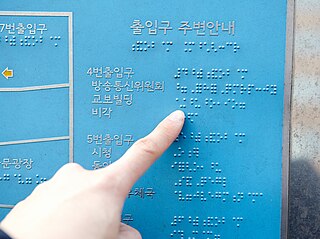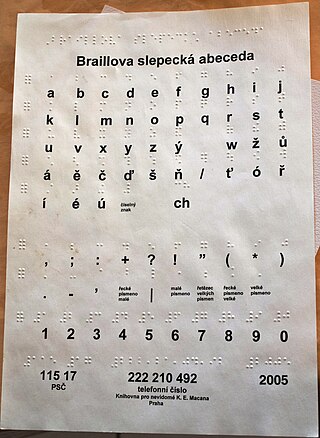
Braille is a tactile writing system used by people who are visually impaired, including people who are blind, deafblind or who have low vision. It can be read either on embossed paper or by using refreshable braille displays that connect to computers and smartphone devices. Braille can be written using a slate and stylus, a braille writer, an electronic braille notetaker or with the use of a computer connected to a braille embosser.

Korean Braille is the Braille alphabet of the Korean language. It is not graphically-related to other braille scripts found around the world. Instead, it reflects the patterns found in Hangul, and differentiates initial consonants, vowels, and final consonants.

Japanese Braille is the braille script of the Japanese language. It is based on the original braille script, though the connection is tenuous. In Japanese it is known as tenji (点字), literally "dot characters". It transcribes Japanese more or less as it would be written in the hiragana or katakana syllabaries, without any provision for writing kanji.

(Mainland) Chinese Braille is a braille script used for Standard Mandarin in China. Consonants and basic finals conform to international braille, but additional finals form a semi-syllabary, as in zhuyin (bopomofo). Each syllable is written with up to three Braille cells, representing the initial, final, and tone, respectively. In practice tone is generally omitted as it is in pinyin.
Vietnamese Braille is the braille alphabet used for the Vietnamese language. It is very close to French Braille, but with the addition of tone letters. Vietnamese Braille is known in Vietnamese as chữ nổi, literally "raised letters", while electronic braille displays are called màn hình chữ nổi.
Thai Braille (อักษรเบรลล์) and Lao Braille (ອັກສອນເບຣລລ໌) are the braille alphabets of the Thai language and Lao language. Thai Braille was adapted by Genevieve Caulfield, who knew both English and Japanese Braille. Unlike the print Thai alphabet, which is an abugida, Thai and Lao Braille have full letters rather than diacritics for vowels. However, traces of the abugida remain: Only the consonants are based on the international English and French standard, while the vowels are reassigned and the five vowels transcribed a e i o u are taken from Japanese Braille.
Tibetan Braille is the Braille alphabet for writing the Tibetan language. It was invented in 1992 by German social worker Sabriye Tenberken. It is based on German braille, with some extensions from international usage. As in print, the vowel a is not written.

The Esperanto language has a dedicated braille alphabet. One Esperanto braille magazine, Esperanta Ligilo, has been published since 1904, and another, Aŭroro, since 1920.
The goal of braille uniformity is to unify the braille alphabets of the world as much as possible, so that literacy in one braille alphabet readily transfers to another. Unification was first achieved by a convention of the International Congress on Work for the Blind in 1878, where it was decided to replace the mutually incompatible national conventions of the time with the French values of the basic Latin alphabet, both for languages that use Latin-based alphabets and, through their Latin equivalents, for languages that use other scripts. However, the unification did not address letters beyond these 26, leaving French and German Braille partially incompatible and as braille spread to new languages with new needs, national conventions again became disparate. A second round of unification was undertaken under the auspices of UNESCO in 1951, setting the foundation for international braille usage today.

French Braille is the original braille alphabet, and the basis of all others. The alphabetic order of French has become the basis of the international braille convention, used by most braille alphabets around the world. However, only the 25 basic letters of the French alphabet plus w have become internationalized; the additional letters are largely restricted to French Braille and the alphabets of some neighboring European countries.

Czech Braille is the braille alphabet of the Czech language. Like braille in other Latin-script languages, Czech Braille assigns the 25 basic Latin letters the same as Louis Braille's original assignments for French.
Dutch Braille is the braille alphabet used for the Dutch language in the Netherlands and in Flanders.
Polish Braille is a braille alphabet for writing the Polish language. It is based on international braille conventions, with the following extensions:
Latvian Braille is the braille alphabet of the Latvian language.
Two-cell Chinese Braille was designed in the 1970s and is used in parallel with traditional Chinese Braille in China.
Irish Braille is the braille alphabet of the Irish language. It is augmented by specifically Irish letters for vowels with acute accents in print:
IPA Braille is the modern standard Braille encoding of the International Phonetic Alphabet (IPA), as recognized by the International Council on English Braille.

Spanish Braille is the braille alphabet of Spanish and Galician. It is very close to French Braille, with the addition of a letter for ñ, slight modification of the accented letters and some differences in punctuation. Further conventions have been unified by the Latin American Blind Union, but differences with Spain remain.
Northern Sami Braille is the braille alphabet of the Northern Sami language. It was developed in the 1980s based on the Scandinavian Braille alphabet but with the addition of seven new letters required for writing in Northern Sámi.
Inuktitut Braille is a proposed braille alphabet of the Inuktitut language based on Inuktitut syllabics. Unlike syllabics, it is a true alphabet, with separate letters for consonants and vowels, though vowels are written before the consonants they follow in speech. It was published in 2012 by Tamara Kearney, Manager of Braille Research and Development at the Commonwealth Braille and Talking Book Cooperative. The book ᐃᓕᐊᕐᔪᒃ ᓇᓄᕐᓗ The Orphan and the Polar Bear was the first work transliterated into Inuktitut Braille.







